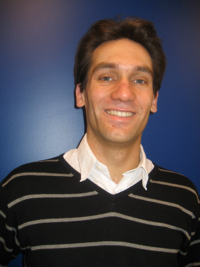Capacitive MEMS-based sensors: Thermo-mechanical stability and charge trapping
Promotion date: 23. January 2009
Promotor: Prof. Dr. Horst Rogalla, assistent-promotor: Dr. Ir. J. Flokstra
| Micro-Electro Mechanical Systems (MEMS) are generally characterized as miniaturized systems with electro-statically driven moving parts. In many cases, the electrodes are capacitively coupled. This configuration allows for many sensitive sensor applications. During fabrication and/or operations of the device, parasitic charge can uncontrollably get trapped and de-trapped in dielectric layers, causing parasitic forces on the device. A cryogenic experimental study has been done on the effect of charge trapping on two types of MEMS-based RF power sensors. New structures have been realized with far better thermo-mechanical immunity. These structures are the first to involve double beam springs, which are fabricated by wet KOH etching of silicon. Existing measurements and imaging of local trapped charges by conducting atomic force microscopy (AFM), are reinterpreted by a new “multi mirror model”. Some interesting theoretical approximations of quantities, describing the interaction between the sample surface containing the trapped charge and the tip of the AFM, have been found. |
How did you come into contact with the topic of your thesis project?
The question already existed at the Low Temperature Division of professor Rogalla, and the EWI-group of Transducers Science & Technology (TST). These phenomena play a role in several developments of new MEMS devices in national EMMA projects. Some of these structures play an important part in superconducting circuits and in space research.
Did this project mean a different approach for you personally, comparing it to former research?
Partly, yes. As a student from Utrecht, I was more involved in general physics, studying fundamental theories and philosophy of science. In Twente, research meant more of a mix of theory and experiment as well as application related issues.
For example, I constructed a new kind of structure, using basic fabrication techniques, where thermo-mechanical disturbances are much less present. By wet etching through silicon, I succeeded in producing two double beam springs into these structures.
On the other hand, my interest in fundamental research paid off, in building a new theoretical model of the measurement process, using the AFM. This approach was dramatically different from existing models, so I had to conceptually rebuild the theoretic framework from scratch. The cantilever properties of the AFM tip fit in very well in my approach, and are accommodated in a much more realistic way.
It sounds like a change of subject took place during your thesis project.
As a preparation for a congress in Noordwijk, in June 2006, I was in a kind of rush and could achieve some important results with charge trapping in MEMS. Quickly after this, we moved the focus to AFM-related research. This certainly was a change of direction, one could say. But when I accepted the thesis project, there was a certain freedom to try and find my own accentuations. My supervisors supported this approach, which was of great help in realising my findings.
What was it like to work at MESA+?
The clean-room staff was very well approachable, as they have a great feeling for the academic type of research involved. Besides being very capable and helpful, there also was a nice informal atmosphere.
One day they decided all users of the clean-room should wear white suits, in order to make the differences between staff and researchers less visible. This wasn’t a very good measure. It is very handy to recognize the staff members by their blue suits. They are the ones that can help you solving problems during fabrication.
There is interaction between the researchers in the clean-room; for example when you share a workbench with someone else, you get to learn about his or her project.
By being part of MESA+ you meet people from all kind of cultural backgrounds, which is very interesting.
My project was not at the core of MESA+ activities, I believe. For the micro structures I studied, cutting edge nano fabrication techniques were not necessary.
What are your future plans?
Right now I am applying for a new job. Two options seem to be feasible right now. Firstly, I have contacts with a company near Eindhoven, that is specialized in numeric simulations for a variety of physical problems. Also a job at the KNMI seems interesting. Here new statistical analyses have to be carried out to meet actual issues of climate change models.

